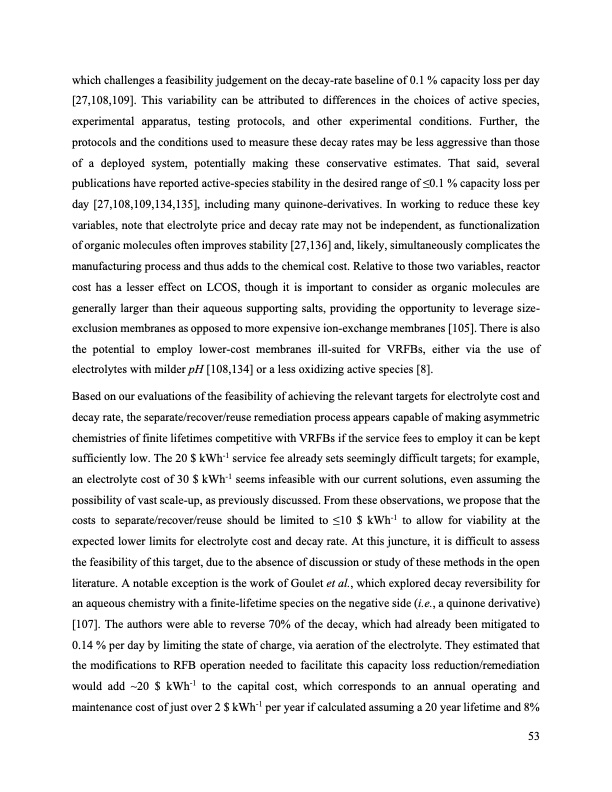
PDF Publication Title:
Text from PDF Page: 053
which challenges a feasibility judgement on the decay-rate baseline of 0.1 % capacity loss per day [27,108,109]. This variability can be attributed to differences in the choices of active species, experimental apparatus, testing protocols, and other experimental conditions. Further, the protocols and the conditions used to measure these decay rates may be less aggressive than those of a deployed system, potentially making these conservative estimates. That said, several publications have reported active-species stability in the desired range of ≤0.1 % capacity loss per day [27,108,109,134,135], including many quinone-derivatives. In working to reduce these key variables, note that electrolyte price and decay rate may not be independent, as functionalization of organic molecules often improves stability [27,136] and, likely, simultaneously complicates the manufacturing process and thus adds to the chemical cost. Relative to those two variables, reactor cost has a lesser effect on LCOS, though it is important to consider as organic molecules are generally larger than their aqueous supporting salts, providing the opportunity to leverage size- exclusion membranes as opposed to more expensive ion-exchange membranes [105]. There is also the potential to employ lower-cost membranes ill-suited for VRFBs, either via the use of electrolytes with milder pH [108,134] or a less oxidizing active species [8]. Based on our evaluations of the feasibility of achieving the relevant targets for electrolyte cost and decay rate, the separate/recover/reuse remediation process appears capable of making asymmetric chemistries of finite lifetimes competitive with VRFBs if the service fees to employ it can be kept sufficiently low. The 20 $ kWh-1 service fee already sets seemingly difficult targets; for example, an electrolyte cost of 30 $ kWh-1 seems infeasible with our current solutions, even assuming the possibility of vast scale-up, as previously discussed. From these observations, we propose that the costs to separate/recover/reuse should be limited to ≤10 $ kWh-1 to allow for viability at the expected lower limits for electrolyte cost and decay rate. At this juncture, it is difficult to assess the feasibility of this target, due to the absence of discussion or study of these methods in the open literature. A notable exception is the work of Goulet et al., which explored decay reversibility for an aqueous chemistry with a finite-lifetime species on the negative side (i.e., a quinone derivative) [107]. The authors were able to reverse 70% of the decay, which had already been mitigated to 0.14 % per day by limiting the state of charge, via aeration of the electrolyte. They estimated that the modifications to RFB operation needed to facilitate this capacity loss reduction/remediation would add ~20 $ kWh-1 to the capital cost, which corresponds to an annual operating and maintenance cost of just over 2 $ kWh-1 per year if calculated assuming a 20 year lifetime and 8% 53PDF Image | Bringing Redox Flow Batteries to the Grid

PDF Search Title:
Bringing Redox Flow Batteries to the GridOriginal File Name Searched:
Rodby-krodby-phd-chemE-2022-thesis.pdfDIY PDF Search: Google It | Yahoo | Bing
Salgenx Redox Flow Battery Technology: Salt water flow battery technology with low cost and great energy density that can be used for power storage and thermal storage. Let us de-risk your production using our license. Our aqueous flow battery is less cost than Tesla Megapack and available faster. Redox flow battery. No membrane needed like with Vanadium, or Bromine. Salgenx flow battery
| CONTACT TEL: 608-238-6001 Email: greg@salgenx.com | RSS | AMP |